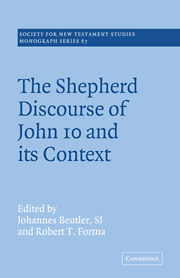Book contents
- Frontmatter
- Contents
- List of abbreviations
- Introduction
- 1 Open questions on John 10
- 2 Der alttestamentlich-jüdische Hintergrund der Hirtenrede in Johannes 10
- 3 The history of religions background of John 10
- 4 Tradition, history and interpretation in John 10
- 5 John 10 and its relationship to the Synoptic Gospels
- 6 A syntactical and narratological reading of John 10 in coherence with chapter 9
- 7 Johannes 10 im Kontext des vierten Evangeliums
- Notes
- Index
6 - A syntactical and narratological reading of John 10 in coherence with chapter 9
Published online by Cambridge University Press: 10 October 2009
- Frontmatter
- Contents
- List of abbreviations
- Introduction
- 1 Open questions on John 10
- 2 Der alttestamentlich-jüdische Hintergrund der Hirtenrede in Johannes 10
- 3 The history of religions background of John 10
- 4 Tradition, history and interpretation in John 10
- 5 John 10 and its relationship to the Synoptic Gospels
- 6 A syntactical and narratological reading of John 10 in coherence with chapter 9
- 7 Johannes 10 im Kontext des vierten Evangeliums
- Notes
- Index
Summary
It is the purpose of this essay to take relevant snapshots of some of the recent developments in the text-linguistic and communicative fields that have been applied methodologically to a syntactical and narratological reading of John 9–10. It is challenging to a New Testament scholar to re-enter the gospel story according to John with freshly awakened interpretative theories and models. I borrow from the theoretical pluralism in the humanities, particularly from general linguistics and literary science.
Demarcation and co-text
From a syntactical point of view chapters 9–10 should be taken as the co-text of John 10 and from a narratological perspective, chapters 5–10. This means that chapter 10 cannot be interpreted as an isolated island in the Johannine gospel sea. The following general observations may be considered:
The introductory words in 9:1 mark a rather abrupt beginning. The phrase καì παράγων shows a break with the previous verse, 8:59. The scene has also shifted from the temple enclosure (8:59) to the scene of the blind man. Jesus has turned away from the temple. The logical coherence and progression in the composition of chapters 9 and 10 flow from the sign (9:1–7), conveyed by various dialogues on the same central theme. The conclusive ending of 10:42 and the start of a totally new narrative about Lazarus in 11:1 figure as a break between chapters 10 and 11. The same audience, place and time indications figure in 10:1 as in chapter 9, and the example of the blind man is recalled in 10:21.
- Type
- Chapter
- Information
- The Shepherd Discourse of John 10 and its Context , pp. 94 - 115Publisher: Cambridge University PressPrint publication year: 1991
- 1
- Cited by



